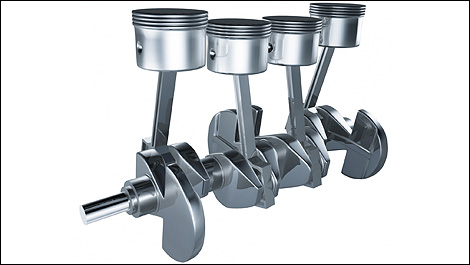Engine distribution and timing
11-8-2008
by
Henri Lebarbé
, moto123.com
|
Other elements have to be considered when talking about power and RPMs. Valve spring calibration is critical for smooth operation; moreover, manufacturers can either opt for a single or double spring design. The type of material used for the valves as well as their lightness will also have an impact on the capacity to sustain higher engine speeds. Heat dissipation efficiency is another optimizing factor. Control of the mobile parts must be extremely precise to prevent air leaks and power gaps.  | | Pistons attached to crankshaft |
Driving the camshaft can either be a chain, a belt or a set of pinions. The crankshaft will always rotate twice (720 degrees) for each camshaft rotation (360 degrees). Nowadays, most engines are using a silent chain (HIVO) that can sustain speeds of up to 4,500 feet per minute, unlike a roller chain. However, some engines still use cascading pinions (the Honda VFR800 is one example, except the VTEC model). There are a few other exceptions, like Ducati's desmodromic system. Here, valves are positively closed by a cam and leverage system consisting of pinions and shims. Additional cams are mounted on the shaft to control the opening and closing of the valves. There are no coil springs. Of course, this system is not found on all of the company's engine models since high-revving capacity is not among the benefits. Photo Credit : Jupiter Images |
|
|

